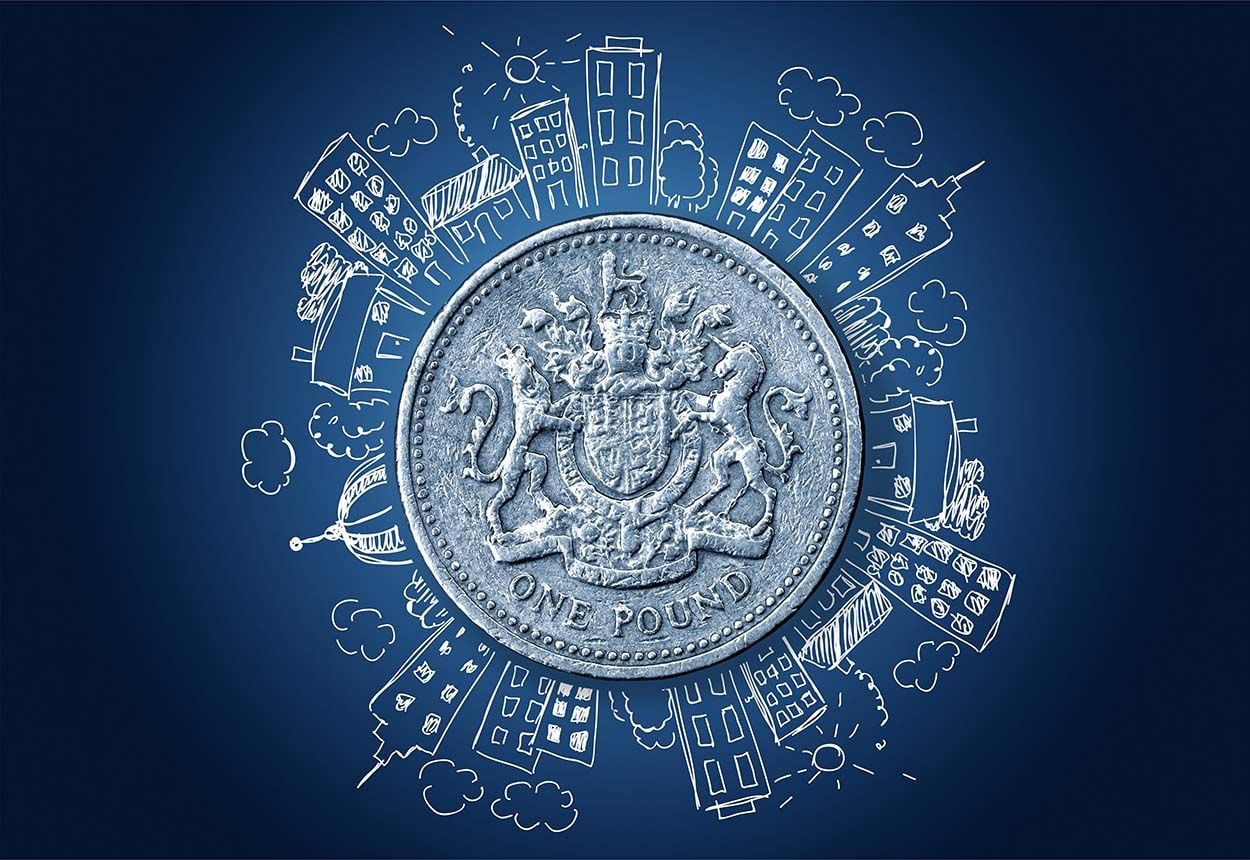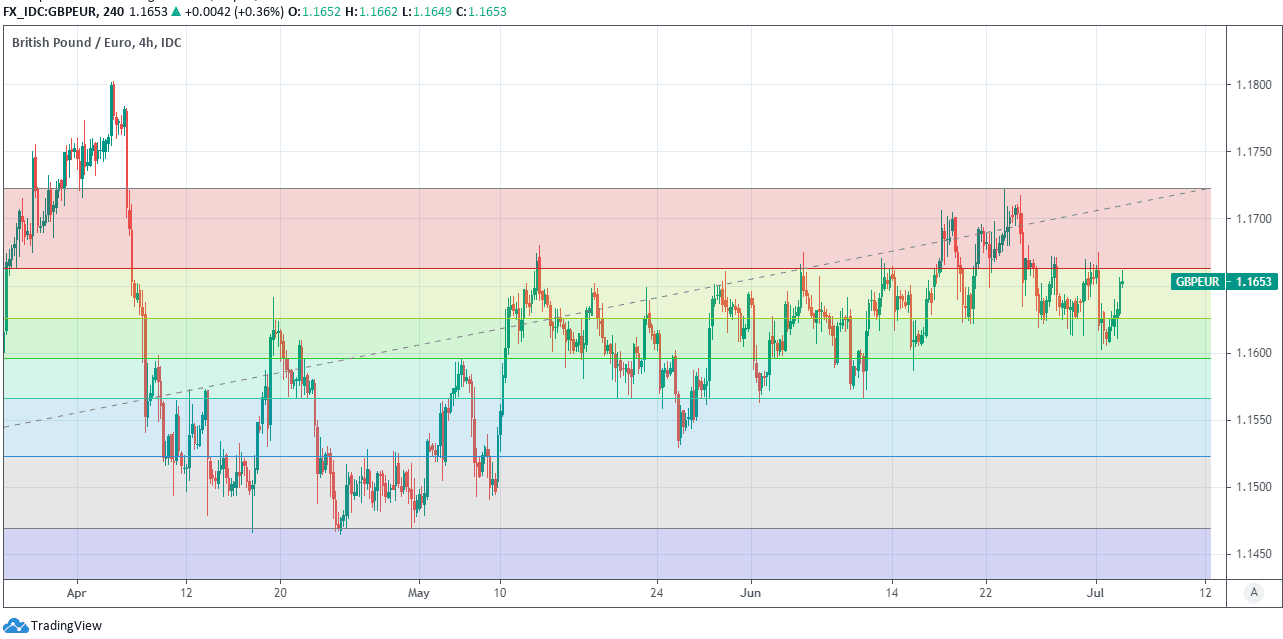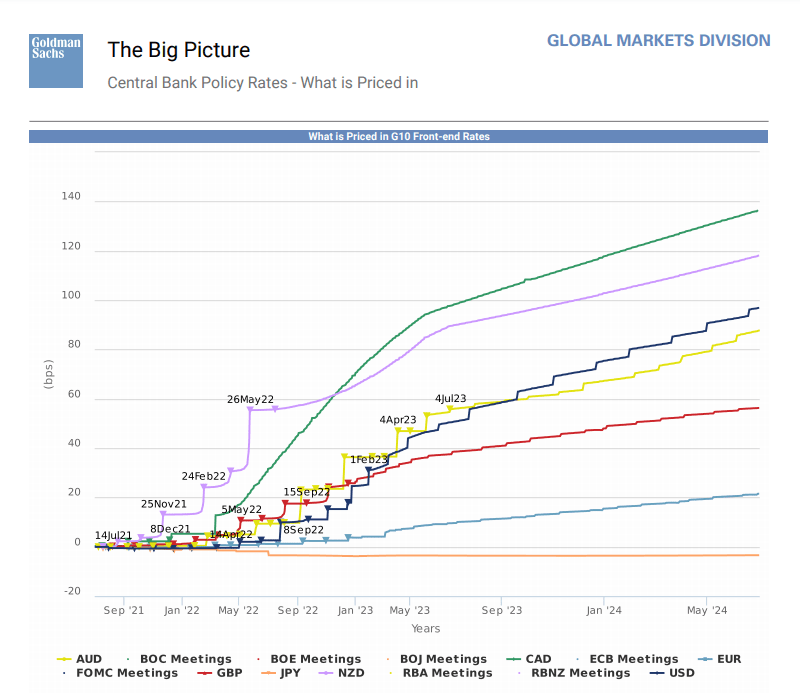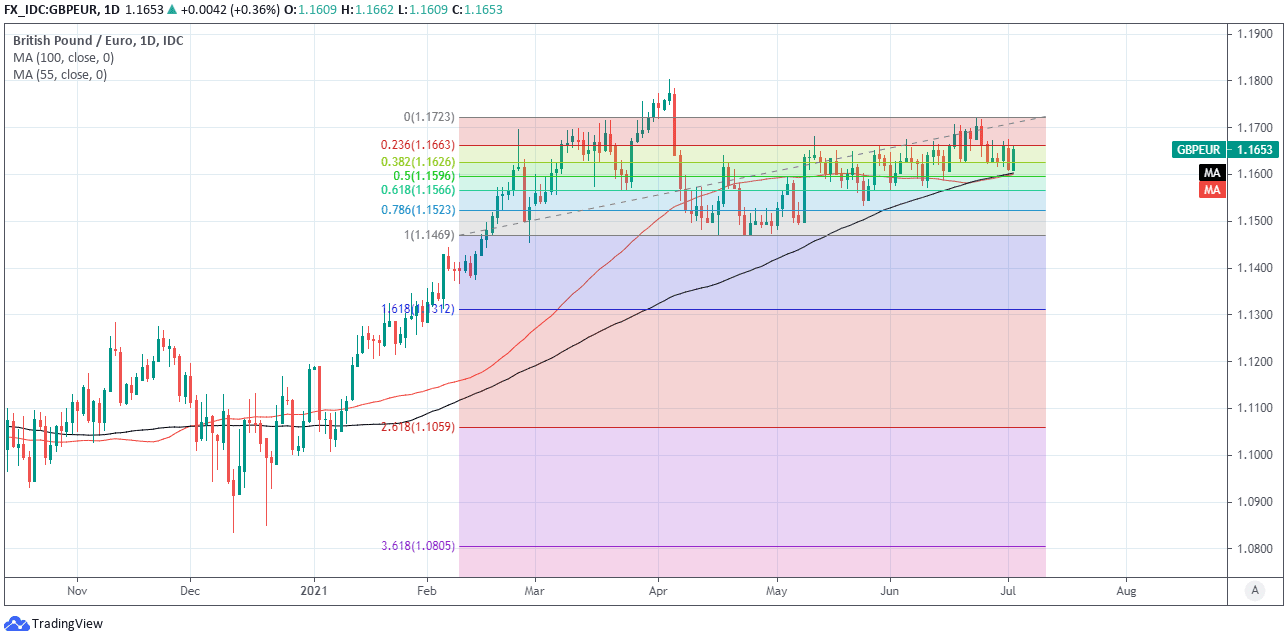Pound-Euro Week Ahead Forecast: Supported at 1.16 with Spotlight On May GDP Data
- Written by: James Skinner
- GBP/EUR supported at 1.16 but upside limited
- Struggling above 1.17 without EUR weakness
- May's GDP data, BoE expectations eyed by GBP

Image © Adobe Images
- GBP/EUR reference rates at publication:
- Spot: 1.1659
- Bank transfers (indicative guide): 1.1357-1.1440
- Money transfer specialist rates (indicative): 1.1560-1.1580
- More information on securing specialist rates, here
- Set up an exchange rate alert, here
The Pound-to-Euro exchange rate enters the new week close to one-month lows but with limited downside given a cluster of nearby support levels around 1.16, which underpins Sterling going into the release of the all-important May GDP report.
This coming Friday’s GDP data for the month of May will reveal the extent to which the economic recovery is thus far living up to Bank of England (BoE) forecasts and would impact Sterling through the effect it has on market expectations for interest rates and other monetary policies of the BoE.
“It’s more meaningful to express the level of activity relative to the end of 2019 (pre-Covid). At the end of last year, the gap was 7¼%, on the latest numbers to the end of April it’s around 5%, and we expect the gap to be closed by the end of this year,” says Governor Andrew Bailey, when addressing an audience at Mansion House in the City of London last week.
Consensus among economists suggests the UK economy grew at a month-on-month pace of 1.9% in May, building on the 2.3% increase seen in April, the first in which supposedly non-essential businesses were permitted to reopen following the second national shutdown last year.
With exchange rates and financial markets focused keenly on the comparative timeframes over which central banks are likely to begin normalising monetary policies including interest rate levels, Friday’s 07:00 GDP report will be important for the Pound-to-Euro rate and Sterling more generally.
“According to Q1’s national accounts, the economy ended the recent lockdown smaller, but only modestly so. And a jump in the household saving ratio confirmed that consumers have plenty of cash to fuel a rebound in spending,” says Martin Beck, lead UK economist at Oxford Economics.
Above: Pound-to-Euro exchange rate shown at 4-hour intervals with Fibonacci retracements of April extension higher.
Secure a retail exchange rate that is between 3-5% stronger than offered by leading banks, learn more.
Economists, markets and the BoE all anticipate a rapid rebound in GDP this year as the UK’s -9.75% decline from 2020 is backfilled with the aid of statistical base effects, taxpayer-funded government spending, central bank monetary policy and what could be as much as hundreds of billions of ‘enforced savings’ that were accrued during the national ‘lockdown’ periods.
“We are sticking with our estimate that month-to-month growth in GDP slowed to about 0.5% in June, from 1.5% in May. And with fiscal support set to be withdrawn in Q4 and higher CPI inflation about to weigh on households' real incomes, we expect quarter-on-quarter growth in GDP to slow to about 2% in Q3 and 1% in Q4, from 5.3% in Q2,” says Samuel Tombs, chief UK economist at Pantheon Macroeconomics.
While views differ among economists, generally bullish expectations of the economy are the basis on which investors and traders have wagered there’s a substantial chance the BoE could lift its interest rate from 0.10% to 0.25% next September or shortly after - as growth impacts on the overall level of the inflation that the BoE is attempting to manage with its interest rate and other monetary policy tools.
{wbamp-hide start}
{wbamp-hide end}{wbamp-show start}{wbamp-show end}
“We expect GDP to increase by 1.4%mom in May (released 9 July) and 1.3%mom in June,” says Steffan Ball, chief UK economist at Goldman Sachs, who sees the UK economy growing by an annualised 8% this year in what is one of the most bullish forecasts of all seen by Pound Sterling Live.
“While we remain comfortable with our above-consensus growth view for the UK, there are both upside and downside risks to our projection. Activity could be weaker than expected should the covid delta variant lead to increased hospitalisations and a further delay in the reopening, whereas a faster rundown in excess savings could push up growth significantly,” Ball cautions.
‘Hawkish’ market bets on the outlook for BoE interest rates have persisted even after the bank indicated in minutes of June’s policy decision that it sees these wagers as premature, a sentiment which was almost seconded in last week’s address at Mansion House by Governor Bailey when he said the current above-target levels of inflation are likely a purely temporary and pandemic-related phenomenon.
Above: Goldman Sachs graph showing market expectations for changes in major central bank policy rats (BoE in red).
Governor Bailey reiterated the June message of the Monetary Policy Committee last week when saying the BoE expects that after a further short period of elevated price pressures, inflation rates will likely return to pre-coronavirus levels and trends that saw the consumer price index generally rising by around, or otherwise less than 2% per year.
“Although caution was Bailey’s central message, there was evidence of an evolution of thinking within the MPC. In his speech, Bailey does outline the risks to the central outlook on inflation. The Bank is on the lookout in case price increases prove to be more sustained,” says Jane Foley, head of FX strategy at Rabobank.
“GBP is likely to draw some influence from forthcoming releases of May monthly GDP, production data and on July 14 of the June CPI inflation release,” Foley adds.
Rabobank’s Foley forecasts the Pound-to-Euro rate will rise to around 1.19 over the next six months but sees little upside for Sterling in the short-term due to lack of data and the resulting uncertainties about how the economy and inflation is likely to develop over the coming years, a sentiment which is supported by how Sterling has persistently struggled to sustain itself above the 1.17 level.
Above: GBP/EUR at daily intervals, supported by 50% Fibonacci (1.1594) retracement of April extension higher as well as 55 and 100-day moving-averages clustered around 1.16.








